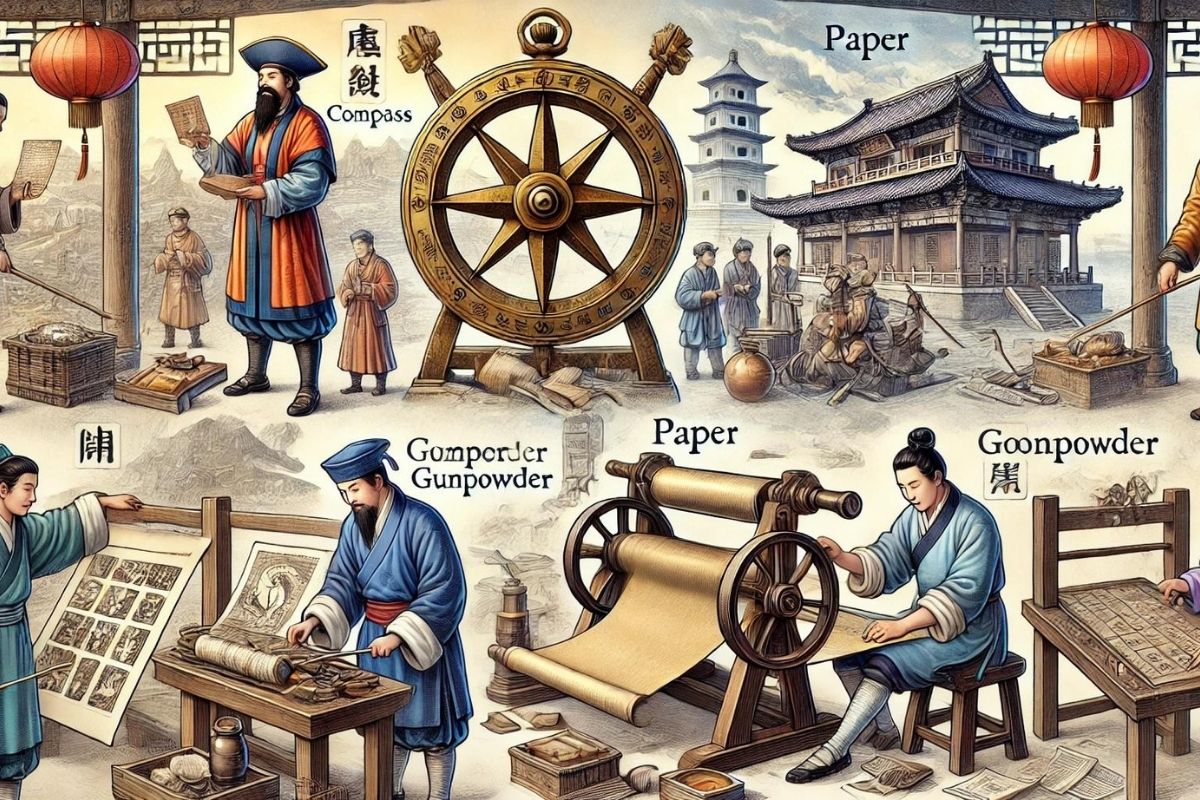The archives of mankind’s set of experiences are loaded with advancements that have pushed social orders into new periods, yet couple of developments have contributed as significantly to the worldwide embroidery of innovation as ancient China. From the modest compass to the loftiness of explosive, ancient Chinese designers changed commonplace materials into wonders that reshaped the world. This blog entry investigates the expansiveness and profundity of these commitments under the title Ancient Chinese Inventions That Changed the World, digging into what these inventions became and the exceptional mean for they have had across the hundreds of years.
The Compass: Exploring New Worlds
Some time before GPS satellites and computerized maps, the ancient Chinese were spearheading techniques to see as their way through the world. The creation of the compass, an apparently basic gadget, upset route and extended the limits of investigation. At first created for geomancy and divination during the Han Line, the attractive compass was adjusted for route by the Tune Administration.
The essential part of this early compass was lodestone, a normally polarized mineral that falls in line with the World’s attractive field. By drifting a lodestone on water or suspending it from a string, early guides could decide cardinal headings even on shady days or during black evenings. This capacity to explore huge seas and obscure landscapes without divine signals empowered not just the extension of shipping lanes across Asia yet additionally essentially affected sea investigation all over the planet.
By lessening the vulnerabilities of ocean travel, the compass helped introduce the Period of Disclosure, when European wayfarers cruised to the edges of the guide, controlled by the information acquired from Chinese development. The attractive compass stays a demonstration of the significant impact that a solitary shrewd creation can have on the worldwide stage, changing it from a device of profound direction to a crucial instrument of investigation.
Papermaking: Spreading Knowledge
Envision a world without paper. This situation would involve an uncommon modification in how information is recorded and shared. Credited to the court official Cai Lun in 105 Promotion, the normalization and refinement of papermaking is among the most significant of ancient Chinese commitments. Before this, texts were engraved on bulky and costly materials like silk, bamboo, and bones.
Cai Lun’s procedure included macerating mulberry bark, hemp, clothes, and fishing nets to frame a mash, which was then squeezed and dried into sheets. This technique made paper generally simple and modest to deliver, which radically democratized the spread of writing and organization. Schools, state run administrations, and researchers could now spread information more generally than any time in recent memory.
The spread of papermaking innovation into the Islamic world and later into Europe by means of the Silk Street reformed bookmaking and, likewise, training and administration. The expansion of paper drove straightforwardly to advancements like the print machine in the fifteenth hundred years, which further sped up the spread of information. In this manner, the ancient Chinese creation of paper supports a lot of our cutting edge trade of thoughts, demonstrating its immortal utility.
Gunpowder: The Force of Explosives
Maybe no creation from ancient China violently affects the world than explosive. Found by Taoist chemists during the ninth hundred years while looking for a mixture of eternality, explosive generally changed fighting and designing across the world. Made out of saltpeter, charcoal, and sulfur, this blend was at first utilized in firecrackers and signals however was immediately adjusted for military use in cannons and guns.
The acquaintance of explosive weaponry with the war zones of Europe and the Islamic world emphatically modified military strategies and the overall influence among states. Strongholds and archaic protective layer turned out to be less successful, prompting changes in military engineering and the ascent of country expresses that could manage the cost of enormous standing armed forces furnished with explosive weapons.
Past fighting, black powder has likewise been basic in structural designing tasks, especially in mining and development, where getting huge wraps free from earth and rock was utilized. The capacity to control scenes quickly sped up improvements in framework and the extraction of regular assets, fueling the Modern Unrest.
Printing: Democratizing the Composed Word
The development of printing, especially woodblock printing and later mobile sort, was one more stupendous commitment by ancient China to worldwide human advancement. Created during the Tang Tradition, woodblock printing included cutting a whole page of text into a solitary block of wood, inking it, and afterward squeezing paper against it to make a print. This innovation was progressive, as it considered the propagation of texts in huge amounts, bringing down the expense of books and making writing more available.
The effect of Chinese printing innovation was significant, especially with the advancement of mobile kind by Bi Sheng in the eleventh 100 years. Albeit less broadly embraced in China because of the intricacy of Chinese characters, versatile sort printing was a forerunner to Gutenberg’s press in Europe, which is frequently credited with birthing the Renaissance and the Logical Upset.
The broad scattering of written words expanded proficiency and instructive levels as well as worked with the spread of novel thoughts across landmasses, speeding up social and logical headways. The tradition of Chinese printing is clear in each book, paper, and banner seen today, representing the persevering through force of shared knowledge.
Ancient Chinese Inventions That Changed the World isn’t only a demonstration of China’s rich history of development yet a sign of how ancient creativity keeps on impacting our cutting edge lives in significant and unavoidable ways. From the compass that directed travelers to the firecrackers illuminating our skies, these inventions help us to remember when the seeds of the present advancements were first planted.


